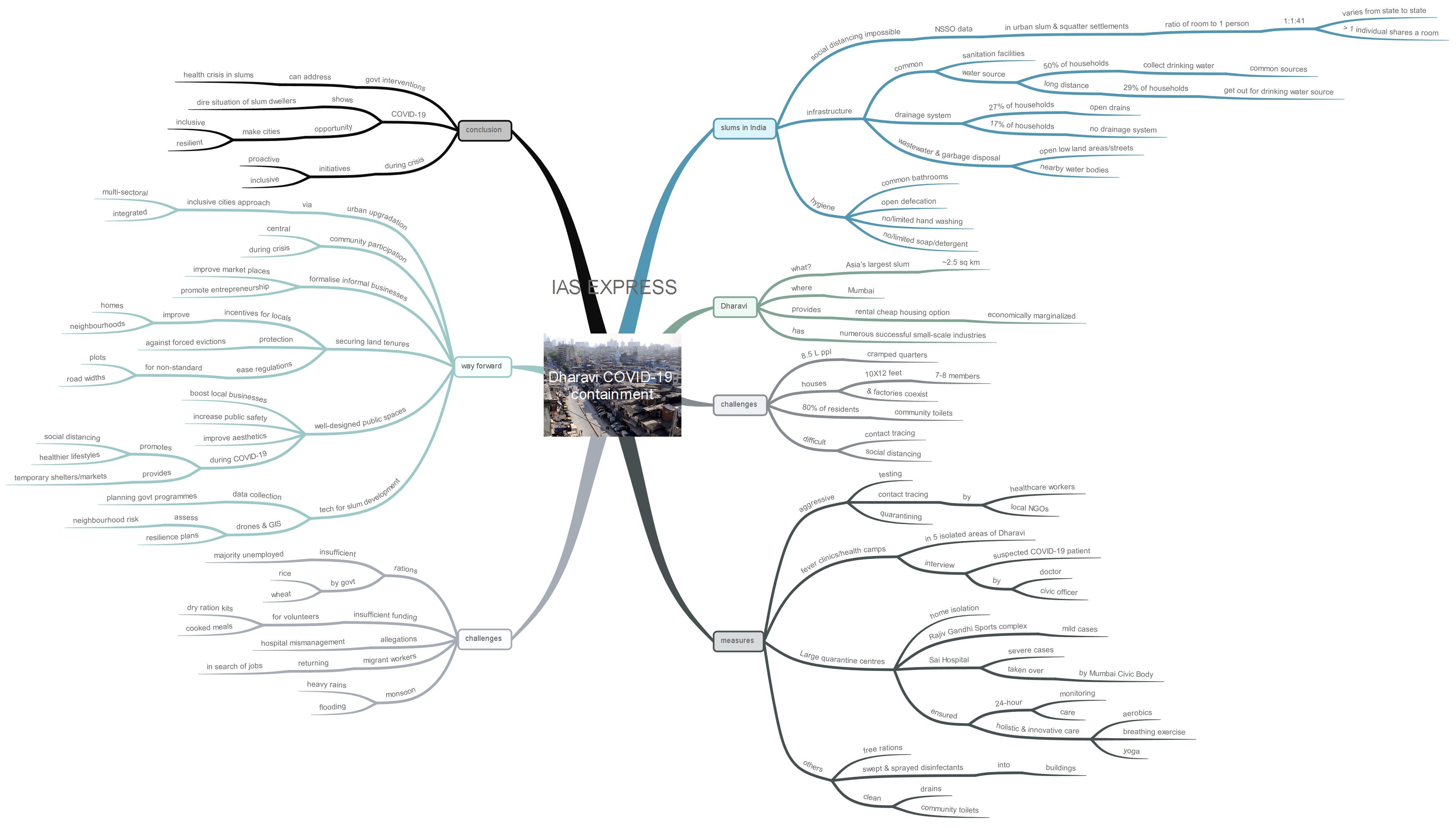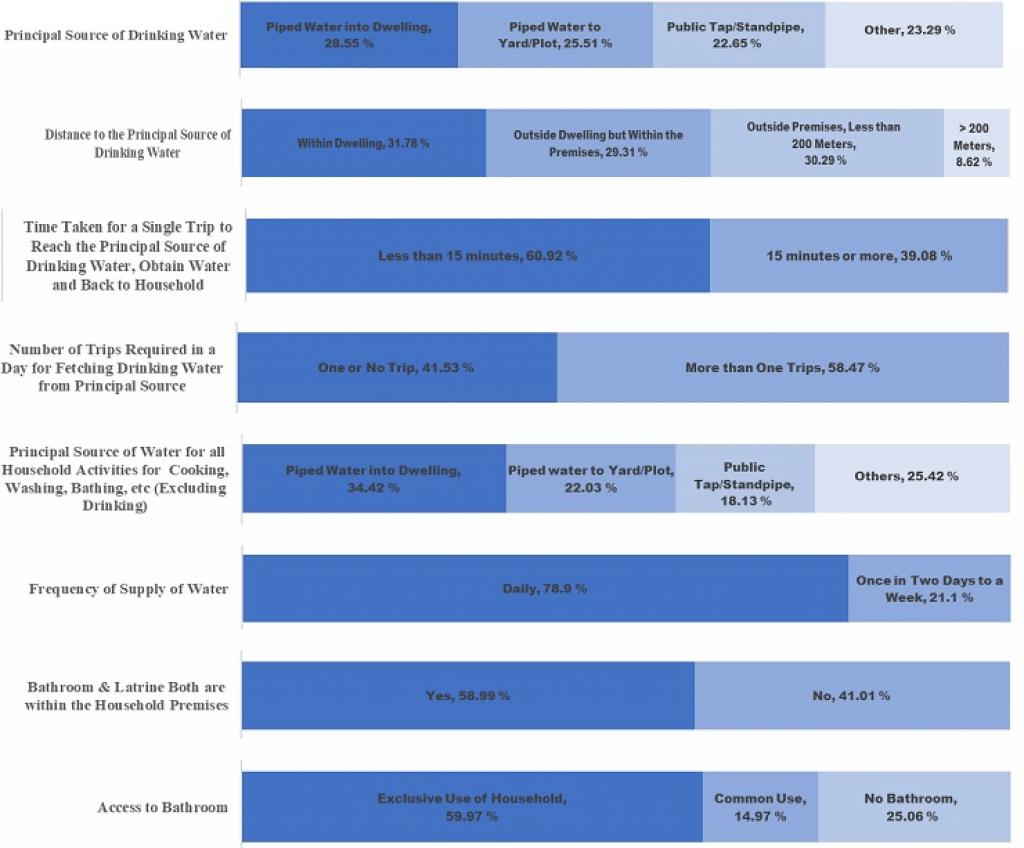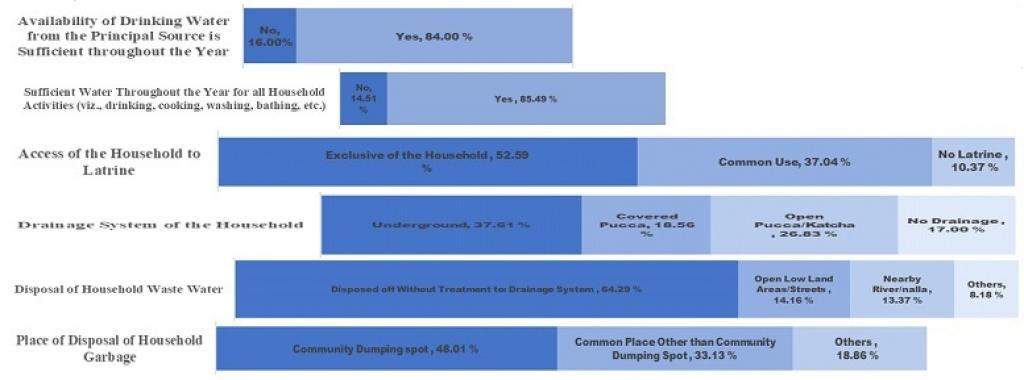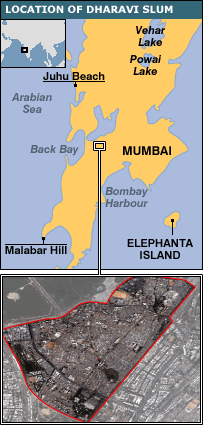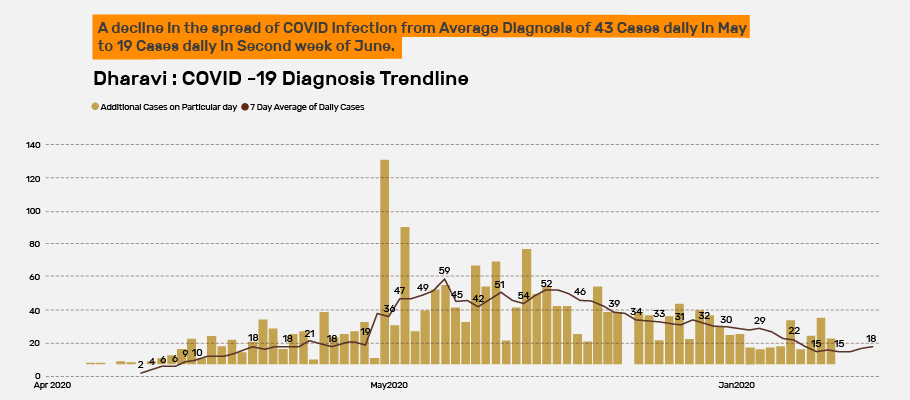Dharavi Model of COVID-19 Containment – Challenges and Way Ahead
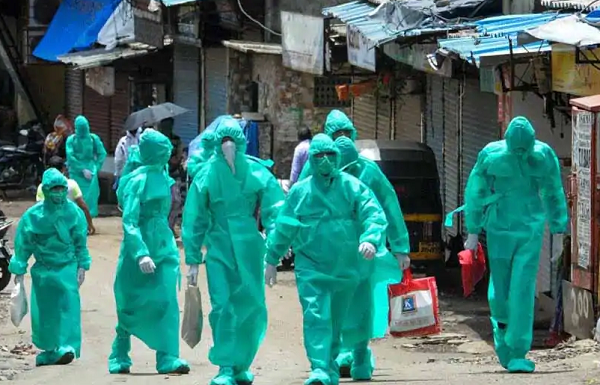
From Current Affairs Notes for UPSC » Editorials & In-depths » This topic
IAS EXPRESS Vs UPSC Prelims 2024: 85+ questions reflected
In India, 5.41 per cent of the total population and 17.37% of the urban population live in slums. Containing disease outbreaks in overcrowded slums, which are inhabited by economically vulnerable population, is highly difficult. Yet, Dharavi, the largest slum in Asia, has succeeded in curbing the COVID-19 spread through a series of innovative measures despite the challenges, making it one of the success stories of COVID-19 containment.
Why are slums the breeding ground for COVID-19?
Practising WHO guidelines of social distancing, frequent handwashing with soap and water and others to combat COVID-19 is either meaningless or impossible in slums. The vulnerabilities of housing and basic amenities of people in slums and squatter settlement in India can be understood from the Indian government’s latest National Sample Survey Office (NSSO) data on Housing and Sanitation in 2018.
Social Distancing:
- According to the NSSO data, the ratio of a room to a person in the urban slum and squatter settlements is 1:1:41. This means that more than one individual shares one room.
- This figure varies from state to state.
- In West Bengal, one room is shared by more than two individuals.
- In Maharashtra, Uttar Pradesh, Delhi, Gujarat and Assam, the ratio is higher than in other parts of India.
- This makes social distancing nearly impossible in urban slums.
- People living in slums and squatter settlements have to come out of their shelters to use common sanitation facilities and collect water to drink and other purposes.
- More than 50% of the households collect drinking water from common sources, including the common use of households in the building, a public or private source restricted or unrestricted to particular communities.
- Of these, 25.63% of households collect water from unrestricted, public sources.
- Therefore, to access water, household members should come out of their homes, where social distancing is not possible.
- Another vulnerability associated with water is the distance to the water source.
- Approximately 29% of the households have to get out of their premises for drinking water and nearly 9% of the households have to walk more than 200 metres to get drinking water.
- The drainage system in slum and squatter settlement also poses a threat as 27% of households have an open drain and 17% have no drainage system.
- As for the wastewater and garbage disposal, households dispose of them in open low land areas/streets and/or in the nearby water bodies.
Hygiene:
- One of the WHO’s advisory to contain COVID-19 outbreak is frequent hand-washing with soap and water.
- However, only 53% of the slum and squatter households wash their hands with water before having their meals and almost 17% use only water to wash after defecation.
- Nearly 37% of the households use common bathrooms, while 10.32% of the households have no bathroom facilities, i.e., open defecation takes place.
- Also, only 27% of the slum and squatter settlement households reported the availability of water. However, they did not have soap/detergent in and around the bathroom.
Dharavi COVID-19 containment:
What and where is Dharavi?
- Dharavi, Asia’s largest slum, is located in the middle of India’s financial capital, Mumbai.
- Spreading over 2.5 square kilometres, it bears no resemblance of the fishing village it once was.
- It is home to more than a million people, many of whom are second-generation residents whose parents moved in years ago.
- For them, it offers affordable rental housing option in a city where house rents are among the highest in the world.
- It is located between Mumbai’s two main suburban rail lines, providing the cheap transport connectivity.
- Dharavi also has a large number of successful small-scale industries that produce embroidered garments, export quality leather goods, pottery and plastics.
- Most of these products are made in tiny manufacturing units spread across the slum and are sold in domestic as well as international markets.
Why is coronavirus containment challenging in Dharavi?
- There are approximately 8.5 lakh people in Dharavi, all living in very close, cramped quarters within a 2.5 square kilometre area.
- Houses here are just 10X12 feet, providing shelter to large families of seven or eight members.
- Around 80% of the residents use community toilets. Approximately 1,400 people use one toilet.
- Homes and factories coexist in single building lining the slum’s narrow lanes.
- This makes it extremely difficult for implementing social distancing and isolation.
- Contact tracing in this densely populated area is also difficult.
What were the measures taken to contain the spread of the coronavirus infection in Dharavi?
Aggressive testing:
- With the aforementioned challenges in mind, the authorities realised that the standard practice of coronavirus containment like social distancing and home isolation is nearly impossible.
- They vigorously traced potential coronavirus cases, tested and quarantined coronavirus cases.
Fever Clinics:
- Coronavirus patients, after being tested positive, are immediately moved into isolation.
- The civic body has set up ‘fever clinics’ or health camps in the five isolated areas of Dharavi for isolating all COVID-19 cases or those who have come in touch with COVID-19 cases.
- Every suspected patient undergoes an interview with a doctor and a civic officer at the clinic.
- While the doctor starts the medical procedure with testing, the civic official starts the process of contact-tracing, where healthcare workers and local NGOs visit every house of people who have come in contact with the patient.
Large quarantine centres:
- Once tested, based on the severity, they are either asked to stay at home or sent to Rajiv Gandhi Sports complex for mild cases or the newly set up Sai Hospital for severe cases.
- The 51-bedded Sai Hosptial, which has 8 ICU beds, along with its doctors, has been taken over by the Mumbai civic body for Rs.30 lakh a month for treating serious coronavirus patients.
- Municipal schools and Mahim Nature Park were also taken over as isolation and quarantine facilities.
- Until June, more than 8,500 were quarantined in such facilities.
- These centres ensured 24-hour monitoring and care. They also provided holistic and innovative care, like putting COVID-19 patients through aerobics, yoga and breathing exercises. This is to keep patients active and help them relax.
Other measures:
- People who were asked to stay at home were provided with free rations.
- The free ration program had assistance from the business communities and donations.
- Sanitary inspectors, along with teams of 150 workers, swept and sprayed disinfectants into the houses, rooms and buildings, while also ensuring that drains are kept clean.
- Community toilets were cleaned to maintain hygiene.
What are the challenges faced while containing the coronavirus outbreak in Dharavi?
- Though Dharavi has surfaced from the worst of the crisis, coronavirus still remains a problem.
- During the lockdown, the municipal corporation sent dry rations to 24,000 families and fed 19,000 people.
- However, this is not sufficient to assist the large portion of the population who remain jobless because of the coronavirus lockdown.
- While the government only provided ration of rice and wheat, it was non-profit and volunteer groups that provided dry ration kits and thousands of cooked meals.
- However, this avenue is drying up because of a decline in donations.
- There were also allegations of mismanagement by the hospitals, which the government refuses vehemently.
- What helped Dharavi’s case in the initial stage of the coronavirus outbreak was the mass exodus of the migrant workers, who returned to their native villages because of the lockdown and the eventual shutting down of businesses in the city.
- Now, there may be a possible second wave as migrants slowly return in search of livelihood.
- There is also the possibility of an increase in cases during the heavy monsoon rains, when the low-lying Dharavi may face flooding.
What is the current coronavirus situation in Dharavi?
- The coronavirus cases in Dharavi have surpassed the 2,500-mark on 21st July with the addition of 10 new cases.
- The civic body, however, has stopped sharing figures of COVID-19 deaths since last month.
- While the first 500 cases were reported in 33 days, the tally crossed 1,000-mark in the next 10 days.
- There were more than 1,500 cases in another 10 days and it took 20 more days to reach 2,000.
- The spread of the coronavirus cases has reduced considerably and it took 39 more days to reach the current level.
What can the way forward?
- Dharavi is one of the rare instances of successful containment of COVID-19 in the most vulnerable areas in the country.
- Challenges faced by slums are not new. However, the on-going coronavirus pandemic has pointed out the need to address this issue as soon as possible.
- Urban upgradation through an integrated and multi-sectoral ‘inclusive cities approach’ must be made a priority. This is to promote the spatial, social and economic inclusion of people in informal settlements.
- It not only improves living conditions for the slum dwellers but also fortifies the public health and stimulates the local economy.
- Community participation and ownership must be at the centre. During a similar crisis like coronavirus outbreak, having channels to connect fellow residents is vital for an effective and time-bound response.
- Those living in slums often depend on informal sectors for their livelihoods, creating a situation of economic uncertainty. While ensuring slum upgradation, market places must be improved and entrepreneurship must be promoted so as to formalise informal businesses.
- Securing land tenures can provide incentives for households to improve their homes and neighbourhoods. It also helps protect slum dwellers against forced evictions. Tenure regularisation and on-site settlement upgrading are possible if regulations are eased to allow for non-standard plot sizes and road widths, which in turn preserves the original layout of the upgraded settlement.
- Well-designed public spaces in informal settlements can boost local businesses, increase public safety and improve aesthetics. In the COVID-19 era, it can promote social distancing and healthier lifestyles and serve as temporary shelters or markets.
- Technology can assist in slum development. It addresses the issue of insufficient data, which has hindered adequate planning for government programmes. Drones and geographic information systems enable the development of detailed neighbourhood risk and resilience plans.
Conclusion:
From the successful containment of COVID-19 in Dharavi, it is evident that government interventions can help address the health crisis in slums, even if it seems nearly impossible. While the global pandemic is shedding lights on the dire situation of slum dwellers, it is also providing an unprecedented opportunity to make cities more inclusive and resilient to help them during a health crisis and thrive in the post-COVID-19 world. Proactive and inclusive initiatives are the key to preventing the repetition of similar outbreaks and health crisis in informal settlements.
Practice question for mains:
The World Health Organisation lauded COVID-19 containment measures in Dharavi. Critically examine the measures that were taken and future challenges. (250 words)
If you like this post, please share your feedback in the comments section below so that we will upload more posts like this.
